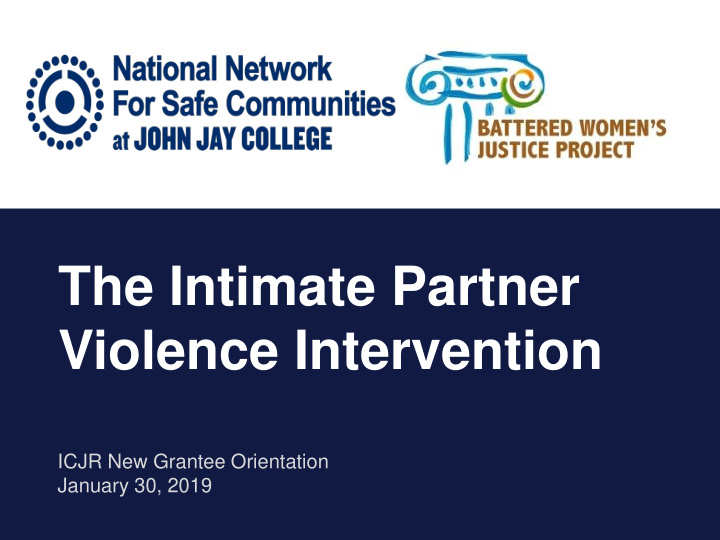



The Intimate Partner Violence Intervention ICJR New Grantee Orientation January 30, 2019
Innovation Upon an Established Framework The NNSC’s Intimate Partner Violence Intervention (IPVI) is a new, innovative approach to reducing serious intimate partner violence, grounded in the same core principles and focused deterrence theory that drive David Kennedy’s other evidence based interventions. Through a close partnership between law enforcement, social service providers, and community members, the IPVI strategy provides jurisdictions with a framework to identify and deter the most serious IPV offenders, reduce IPV, and reduce harm to victims.
IPVI Goals • Do no harm • Addresses as many offenders as possible: • Protect victims who are counters the most at risk from the “experiential effect,” most dangerous offenders establish new norms • Deter or prevent • Match with best possible offending victim support and • Take the burden off protection victims and place it on the CJ system • Mobilize the community’s moral voice • Establish state, not against violence victim, as addressing violence
IPVI Approach IPVI Model Traditional Model D B C B vs A A A A Low Intensity High Intensity Response Response
IPVI Operational Elements Conduct qualitative and quantitative data analysis of local dynamics (“problem analysis”) Identify levels of offenders Engage each level of offender with a specific approach and offer of help Elevate offenders to the appropriate higher level if continued offending occurs, emphasize risks Provide affirmative outreach to victims at every level
Parallel Notifications Methods for law enforcement, community, and service providers to talk directly to offenders and victims: Offenders: removing anonymity, providing a clear message of legal consequences for further offending, stressing that criminal justice response is not coming from victim, offering support & outreach to those who want it. Victims: advising them of all contacts with offenders, providing resources and support to plan for safety, informing them that the burden to stop the violence is not on them.
Sample Offending Notification and Response Notification letter from partnership, delivered by LE, explains IPVI and D – Level LE procedures. Offer of help. Affirms this is not by victim request. First Contact Face-to-face deterrent message from LE. Notification letter from C – Level partnership delivered by LE. Offer of help. Affirms this is not by victim First Charge request. B – Level Face-to-face deterrent message from LE. Notification letter from partnership Repeat with custom legal assessment. When appropriate, face-to-face LE and Offender community message (call-in). Offer of help. Affirms this is not by victim request. A – Level Addressed by any legal means available to the partnership (pulling Most levers). Dangerous
General Reoffending Notification and Response Notification letter from police explains IPVI and LE procedures; D – Level Offer of help; Affirms this is not by victim request First Contact Face-to-face deterrent message and letter from LE; Offer of C – Level help; Affirms this is not by victim request First Charge Notification letter with custom legal assessment. When B – Level appropriate, face-to-face LE and community message —”call - in”. Repeat Offer of help. Affirms this is not by victim request Offender A – Level Addressed by any legal means available to the partnership Most (“pulling levers”) Dangerous
General Victim Notification and Response Structure Explanation of IPVI model and available services; D – Level Affirmative outreach from victim advocates; Letter First Contact Explanation of IPVI and available services; Affirmative C – Level outreach from victim advocates; Letter; Follow-up from LE First Charge B – Level Affirmative outreach; Letter; Notice of offender being called-in; Repeat Review of message; Safety planning; Post-call-in contact Offender Victim assessed on scene if possible for emergency needs; A – Level Affirmative outreach and communication regarding all Most Dangerous offender contacts
Victim Notifications • Develop notification strategy that “matches” • Notification language is clear and straightforward about the strategy, partners, and help that is available • Share the same information that was given to offenders with victims • When circumstances allow, affirmative outreach prior to offender notifications • At higher levels, affirmative outreach before and after any offender contact
Impact on High Point remaining homicides were DV related 1 out of 3 including two murder/suicides HPPD Officers responded to more than 5,000 DV calls per year , including 5,352 in 2010 Average on scene time is 26 minutes x 2 officers = 6,472 hours on DV calls that year
Results IPV Homicide in High Point 18 5 IPV homicides pre- IPV homicides post- implementation (2002-2008) implementation (2009-2017)
Results, cont’d Recidivism Rate of Notified Offenders April 1, 2012 – April 1, 2017 2,165 Notified Reoffended 1,702 405 363 290 57 58 45 16 5 D-Level C-Level B-Level A-Level Total
Lessons Learned • Procedural justice can deter crime • Offender accountability is increased when: • Law enforcement clearly notifies offenders about the legal consequences of their actions • Protective orders are explained and consistently enforced • Increased victim trust can deter and interrupt IPV: • When victims know what to expect from the CJ system, they’re more likely to reach out for help • Victims are more likely to report crimes earlier and more often • This helps law enforcement both stop and effectively prosecute IPV crimes, especially before they escalate or become lethal
Rachel Teicher Director, IPVI rteicher@jjay.cuny.edu Sandi Tibbetts Murphy Legal & Policy Advisor smurphy@bwjp.org
Recommend
More recommend